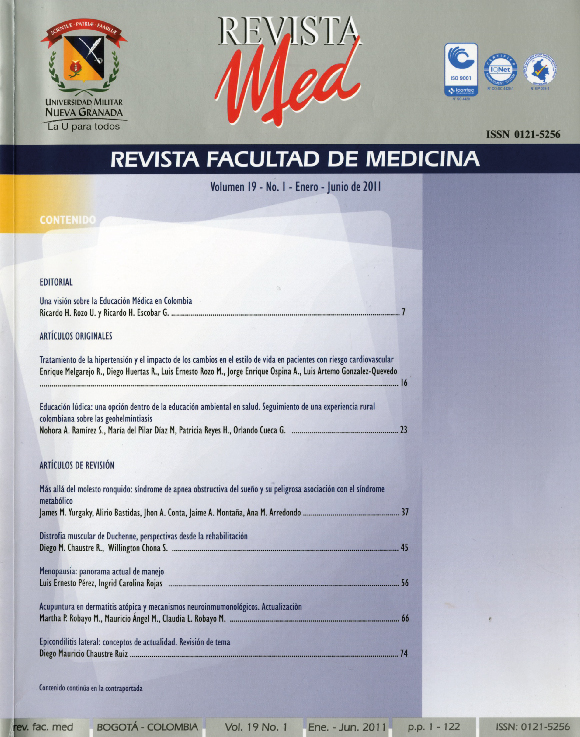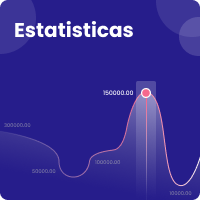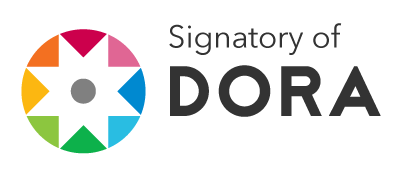Menopausia: panorama actual de manejo
Resumo
Aún existe, desde 2002, una marcada disminución en el uso de terapia hormonal clásica (TH), para el manejo de la menopausia, debido a los riesgos determinados en el estudio Iniciativa de salud para las mujeres (WHI: Women’s Health Initiative). No obstante, revisiones del WHI y evidencias actuales determinan que la TH: (a) es la terapia más efectiva de los síntomas vasomotores, de sus potenciales consecuencias (disminución en calidad del sueño, irritabilidad, reducción en calidad de vida), y para tratar la atrofia urogenital. (b) Previene la osteoporosis y en pacientes con endotelios sanos, reduce el riesgo de hipertensión arterial, diabetes II y enfermedad coronaria, siendo el cociente beneficio/ riesgo mayor cuando se inicia tempranamente al sucederse el hipoestrogenismo. (c) Existe la tendencia a utilizar dosis mínimas, estrógenos no orales y progestágenos puros, para disminuir sus riesgos. (d) Tibolona y paroxetina son las mejores alternativas para tratar los síntomas vasomotores. (e) Finalmente, los cambios a estilo de vida saludable son coadyuvantes excelentes de la TH en el manejo de los síntomas menopaúsicos y en la prevención de las enfermedades crónicas de la postmenopausia, las cuales ameritan tratamientos específicos.
Downloads
Referências
Gómez G. Menopausia: Una visión Global. En: Pérez L E. Infertilidad y Endocrinología Reproductiva. Tercera edición basada en evidencias. Barranquilla - Colombia. Grafimpresos Donado; 2007. p 423-33.
Brantes S. Perimenopausia. En: Climaterio y Menopausia en el siglo XXI. Santiago de Chile. Imprenta Naval LTDA; 2010. p 22-28.
Van Rooij I, Broekmans F, Scheffer G. et al. Serum antimullerian Hormone levels best reflect the reproductive decline with age in normal women with proven fertility: a longitudinal study. Fertil Steril. 2005;83:979-87.
Daley A, Stokes-Lampard H, Macarthur C. Exercise for vasomotor menopausal symptoms. Cochrane Database Syst Rev. 2011;11; 5:CD006108.
Holloway D. An overview of the menopause: assessment and management. Nurs Stand. 2011;5;25(30):47-57.
Arteaga Urzua E. Terapia de reemplazo hormonal clásica. En: Climaterio y Menopausia en el siglo XXI. Santiago de Chile. Imprenta Naval LTDA; 2010.p 241-9.
The Women’s Health Initiative Steering Committee. Benefits of estrogen plus progestin in healthy postmenopausal women. Principal results from the Women’s health Initiative randomized controlled trial. JAMA. 2002; 288:321-33.
The Women’s Health Initiative Steering Committee. Effects of conjugated equine estrogens in postmenopausal women with hysterectomy: The Women’s Health Initiative randomized controlled trial. JAMA. 2004;291:1701-1.
The North American Menopause Society (NAMS). Estrogen and progestogen use in peri-and postmenopausal women: march 2007 position statement of the North American Menopause society. Menopause. 2007;14:1-17.
The North American Menopause Society (NAMS). Estrogen and progestagen use in postmenopausal women: position statement 2008. Menopause. 2008;15(4):584-603.
The North American Menopause Society (NAMS). Estrogen and progestogen use in postmenopausal women: 2010 position statement of the North American Menopause society. Menopause. 2010;17:242-55.
The society of Obstetricians and Gynaecologist of Canada. Menopausia and osteoporosis: Vasomotor symptoms, update 2009. JOGC. 2009;1(S9).
Cuadros J L, Fernández-Alonso A M, Chedraui P, et al. Metabolic and hormonal parameters in post-menopausal women 10 years after transdermal oestradiol treatment, alone or combined to micronized oral progesterone. Gynecol Endocrinol. 2011;27(3):156-62.
Wang P H, Horng H C, Cheng M H, Chao H T, Chao K C. Standard and low-dose hormone therapy for postmenopausal women—focus on the breast. Taiwan J Obstet Gynecol. 2007;46(2):127-34.
Harman S M, Brinton E A, Cedars M, et al. KEEPS: The Kronos Early Estrogen Prevention Study. Climacteric. 2005 Mar;8(1):3-12.
Rossouw J E, Prentice R L, Manson J E, et al. Postmenopausal hormone therapy and risk of cardiovascular disease by age and years since menopause. JAMA. 2007;297(13):1465-77.
Hodis H N, Mack W J. Coronary heart disease and hormone replacement therapy after the menopause. Climacteric. 2009;12(1):71-5.
Manson J E, Allison M A, Rossouw J E, et al. Estrogen therapy and coronary-artery calcification. N Engl J Med. 2007;356(25):2591-602
Hofling M, Carlstrom K, Svane G, et al. Different effects of tibolone and continuous combined estrogen plus progestogen hormone therapy on sex hormone binding globulin and free testosterone levels – an association with mammographic density. Gynecol Endocrinol. 2005:20(2):110-15.
Segovia A. Tibolona. En: Climaterio y Menopausia en el siglo XXI. Santiago de Chile. Imprenta Naval LTDA; 2010. p 250-256.
Archer D F. Endometrium and breast endpoints study (THEBES). RCT multicenter. Fertil Steril. 2007;88(4):866-78.
Broutin G. Terapia no hormonal para el manejo del síndrome climatérico. En: Climaterio y Menopausia en el siglo XXI. Santiago de Chile. Imprenta Naval LTDA; 2010.p 268-72.
Lethaby AE, Brown J, Marjoribanks J, Kronenberg F, Roberts H, Eden J. Phytoestrogens for vasomotor menopausal symptoms. Cochrane Database Syst Rev. 2007;(4):CD001395.
Jacobs A, Wegewitz U, Sommerfeld C, Grossklaus R, Lampen A. Efficacy of isoflavones in relieving vasomotor menopausal symptoms – A systematic review. Mol Nutr Food Res. 2009;53(9):1084-97.
Bolaños R, Del Castillo A, Francia J. Soy isoflavones versus placebo in the treatment of climacteric vasomotor symptoms: systematic review and meta-analysis. Menopause. 2010;17(3):660-6.
Pastore L M, Carter R A, Hulka B S, Wells E. Self-reported urogenital symptoms in postmenopausal women: Women’s Health Initiative. Maturitas. 2004;49:292-303.
Society of Obstetricians and Gynecologists of Canada. The detection and management of vaginal atrophy. Int J Gynaecol Obstet. 2005;88:222-8.
Subak L L, Brown J S, Kraus S R, Brubaker L, Lin F, Richter H E, et al; Diagnostic Aspects of Incontinence Study Group. The “costs” of urinary incontinence for women. Obstet Gynecol. 2006;107:908-16.
The society of Obstetricians and Gynaecologist of Canada. Menopausia and osteoporosis: Urogenital health. Update. 2009. JOGC. 2009;1(S27).
Graziottin A. Menopause and sexuality: key issues in premature menopause and beyond. Ann N Y Acad Sci. 2010;1205:254-61.
Nappi R E, Lachowsky M. Menopause and sexuality: prevalence of symptoms and impact on quality of life. Maturitas. 2009;63(2):138-41.
Bromberger J, Matthews K, Schott LL, Brockwell S, Avis NE, Kravitz HM, et al. Depressive symptoms during the menopausal transition: the Study of Women’s Health Across the Nation (SWAN). J Affect Disord. 2007;103:267-72.
Woods N F, Smith-DiJulio K, Percival D B, Tao E Y, Mariella A, Mitchell ES. Depressed moo d during the menopausal transition and early postmenopause: observations from the Seattle Midlife Women’s Health study. Menopause. 2008;15:223-32.
Sherwin B B, Henry J F. Brain aging modulates the neuroprotective effects of estrogen on selective aspects of cognition in women: A critical review. Front Neuroendocrinol. 2008;29(1):88-113.
Almeida O P, Lautenschlager N, Vasikaram S, Leedman P, Flicker L. Association between physiological serum concentration of estrogen and the mental health of community-dwelling postmenopausal women age 70 years and over. Am J Geriatr Psychiatry. 2005;13(2):142-9.
Hogervorst E, Bandelow S. Sex steroids to maintain cognitive function in women after the menopause: meta-analyses of treatment trials. Maturitas. 2010;66(1):56-71.
Coker L H, Espeland M A, Rapp S R, Legault C, Resnick S M, Hogan P et al. Postmenopausal hormone therapy and cognitive outcomes: the Women’s Health Initiative Memory Study (WHIMS). J Steroid Biochem Mol Biol. 2010;118(4-5):304-1.
The society of Obstetricians and Gynaecologist of Canada. Menopausia and osteoporosis: Mood, memory and cognition. Update 2009. JOGC 2009;1(S31).
Daviglus M L, Bell C C, Berrittini W et al. Stete of the science. Conference statement: preventing Alzheimer disease and cognitive decline. Ann Int Med. 2010;153(3):176-81.
Melgarejo E. El problema riesgo cardiovascular en la mujer: la ignorancia que mata. Epidemiología, fisiopatología. En, Asociación colombiana de menopausia. Taller salud cardiovascular en el climaterio. Bogotá. Editorial Guadalupe; 2010. p 11-14.
Hulley S, Grady D, Bush T, et al. Randomized trial of estrogen plus progestin for secondary prevention of coronary heart disease in postmenopausal women. Heart and Estrogen/progestin Replacement Study (HERS) Research Group. JAMA. 1998;280(7):605-13.
Allison M A, Manson J E, Langer R D et al. Oophorectomy, hormone therapy and subclinical coronary artery disease in women with hysterectomy; the WHI coronary artery calcium study. Menopause. 2008;15:639-47.
Stevenson J C, Nodis H N, Pickar J H et al. Coronary heart disease and menopause management: The swinging pendulum of HRT. Atherosclerosis. 2009;207:336-40.
Harman S M, Vittinghoff E, Brinton E A et al. Timing and duration of menopausal hormone treatment may affect cardiovascular outcomes. Am J Med. 2011;124(3):199-205.
LaCroix A Z, Chlebowski R T, Manson J E et al. Health outcomes after stopping conjugated equine estrogens among postmenopausal women with prior hysterectomy: A randomized controlled trial. JAMA. 2011;305(13):1305-14.
Salpeter S R, Cheng J, Thabane L, Buckley NS, Salpeter EE. Bayesian meta-analysis of hormone therapy and mortality in younger postmenopausal women. Am J Med. 2009;122(11):1016-22.
The society of Obstetricians and Gynaecologist of Canada. Menopausia: Cardiovascular disease. Update 2009. JOGC. 2009;1(S11).
Pollak F. Alteraciones del metabolismo de los hidratos de carbono en la menopausia. En: Climaterio y Menopausia en el siglo XXI. Santiago de Chile. Imprenta Naval LTDA; 2010.p. 137-43.
Chlebowski R T, Anderson G L, Gass M, et al. Estrogen plus progestin and breast cancer incidence and mortality in postmenopausal women. JAMA. 2010;304(15):1684-92.
Bolland M J, Barber P A, Doughty R N, Mason B, Horne A, Ames R et al. Vascular events in healthy older women receiving calcium supplementation: randomised controlled trial. BMJ. 2008;336(7638):262-6.
Agarwal S, Agarwal N, Arya S C. Hypovitaminosis D3 in menopausal women in a tertiary care hospital in Delhi. Women’s Health. 2011;7(5):607-10.
Society of Obstetricians and Gynecologists of Canada. Menopause and osteoporosis update 2009. Journal of Obstetrics and Gynecology. 2009;2:27-29.
Khosla S. Update on estrogens and the skeleton. J Clin Endocrinol Metab. 2010;95(8):3569-77.
Britto R, Araújo L, Barbosa I, Silva L, Rocha S, Valente A P. Hormonal therapy with estradiol and testosterone implants: bone protection? Gynecol Endocrinol. 2011;27(2):96-100.
Lee W L, Chao H T, Cheng M H, Wang P H. Rationale for using raloxifene to prevent both osteoporosis and breast cancer in postmenopausal women. Maturitas. 2008;60(2):92-107.
Messalli E M, Scaffa C. Long-term safety and efficacy of raloxifene in the prevention and treatment of postmenopausal osteoporosis: an update. Int J Women Health. 2010;1:11-20.
Delmas P D, Adami S, Strugala C et al. Intravenous ibandronate injections in postmenopausal women with osteoporosis: one-year results from the dosing intravenous administration study. Arthritis Rheum. 2006;54:1838-46.
Deeks E D, Perry C M. Zoledronic acid: a review of its use in the treatment of osteoporosis. Drugs Aging. 2008;25(11):963-86.
Finkelstein J S, Wyland J J, Lee H, Neer R M. Effects of teriparatide, alendronate, or both in women with postmenopausal osteoporosis. J Clin Endocrinol Metab. 2010 Apr; 95(4):1838-45.
Lyritis G P, Georgoulas T, Zafeiris C P. Bone anabolic versus bone anticatabolic treatment of postmenopausal osteoporosis. Ann N Y Acad Sci. 2010;1205:277-83.
Deek E D, Dhillon S. Strontium ranelate: A review of its use in the treatment of postmenopausal osteoporosis. Drugs. 2010;70(6):733-59.
Cranney A, Tugwell P, Zytaruk N, et al. Meta-analyses of therapies for postmenopausal osteoporosis. VI. Meta-analysis of calcitonin for the treatment of postmenopausal osteoporosis. Endocr Rev. 2002;23(4):540-51.
Bogado C E, Boailchuk J A, Zanchetta M B, Massari F E, Zanchetta J R. Denosumab: An update. Drugs Today. 2011;47(8):605-13.












